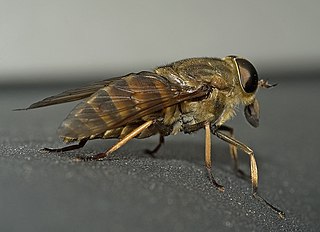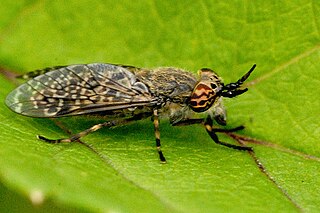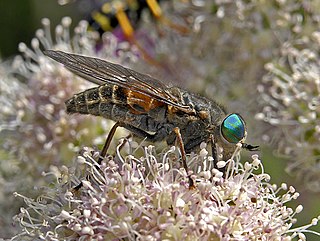
Tabanus cordiger also known as the plain-eyed grey horsefly is a species of biting horse-fly.

Tabanus glaucopis, also known as the downland horsefly, is a species of biting horse-fly.

Tabanus maculicornis also known as the narrow-winged horsefly is a species of biting horse-fly.

Tabanus sudeticus, also known as the dark giant horsefly, is a species of biting horse-fly. It is the heaviest fly in Europe.
Tabanus spodopterus also known as the black horned giant horsefly is a species of biting horse-fly. It is widespread in Europe, but only one doubtful specimen has been found in the United Kingdom.

Haematopota is a genus of flies in the horse-fly family, Tabanidae. Among the horse-flies, they are most commonly known as clegs. Many species have colorful, sinuously patterned eyes in life, a character that fades after death. The wings are typically patterned with spots of grey. The genus is named from the Ancient Greek for blood-drinker: αἷμα, haîma, blood; πότης, pótës, drinker. Some species are known to be vectors of livestock diseases.

Tabanus eggeri is a Mediterranean species of biting horse-fly, found in southern France, Italy, Albania, Croatia, Herzegovina, Bulgaria, Portugal and Morocco. There are also unverified accounts of sightings in Spain and Israel.

Atylotus rusticus is a species of horse-flies in the genus Atylotus. It is found in Europe, Asia and North Africa.

Haematopota pluvialis, the common horse fly or notch-horned cleg fly, or simply cleg in Scotland and northern parts of Ireland, is a species belonging to the family Tabanidae subfamily Tabaninae.

Chrysops caecutiens, common name splayed deer fly, is a species of horse fly belonging to the family Tabanidae. It is also known by the colloquial name Scotch Cleg.

Haematopota crassicornis, the black-horned cleg is a species in the horse-fly family, Tabanidae.
Haematopota bigoti is a species of Horse-fly.
Haematopota grandis is a species of Horse-fly. Its common name is the long-horned cleg. It is native to Europe, where it is distributed in Albania, Austria, Bulgaria, Czech Republic, Denmark, France, Germany, Greece, Hungary, Italy, Moldova, Romania, Slovakia, Spain, Sweden, Switzerland, Ukraine, and all states of former Yugoslavia.

Hybomitra montana, the slender-horned horsefly, is a species of horse flies in the family Tabanidae.

Haematopota pseudolusitanica is a species of horse fly in the family Tabanidae.

Hybomitra muehlfeldi is a species of horse flies belonging to the family Tabanidae. It is a Palearctic species with a limited distribution in Europe.
Hybomitra lurida is a species of horse-fly in the family Tabanidae. It is found across central and Northern Europe and Asia. It is a large fly, between 12–15 millimetres long.

Hybomitra distinguenda is a Palearctic species of horse fly in the family Tabanidae.
Hybomitra expollicata, also known as the striped horsefly, is a Palearctic species of horse fly in the family Tabanidae.
Hybomitra solstitialis is a Palearctic species of horse fly in the family Tabanidae. Continental authorities apply the name solstitialis to the coastal species Hybomitra ciureai of British authorities and regard British solstitialis as var. collini of Hybomitra bimaculata.














